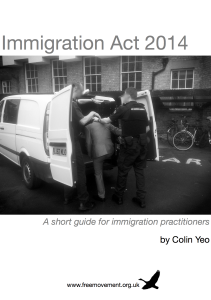- BY Colin Yeo

Statement of Changes HC 532
THANKS FOR READING
Older content is locked

A great deal of time and effort goes into producing the information on Free Movement, become a member of Free Movement to get unlimited access to all articles, and much, much more
TAKE FREE MOVEMENT FURTHER
By becoming a member of Free Movement, you not only support the hard-work that goes into maintaining the website, but get access to premium features;
- Single login for personal use
- FREE downloads of Free Movement ebooks
- Access to all Free Movement blog content
- Access to all our online training materials
- Access to our busy forums
- Downloadable CPD certificates
This post is based on an earlier page I made available to Free Movement Members a couple of weeks ago, before Statement of Changes HC 532 took effect. The commencement date of 28 July 2014 has been and gone and we have also seen commencement of the overseas deportation appeals sections of the Immigration Act 2014 (see blog posts here and here), along with the controversial statutory human rights considerations. I will return to the statutory human rights considerations in another post and will also be updating the online course on the Act. They are already covered in some depth in my ebook on the Act.
Forgive me for the post that follows is quite technical, but that is because the changes are technical in nature. If you spot any errors or think of anything additional, do let me know in the comments.
Appendix FM

Firstly, a reference to the new statutory human rights considerations to be introduced by the Immigration Act 2014 is inserted into GEN.1.1. This takes effect on 28 July 2014, so we can presume that this is the commencement date for those parts of the Act. Indeed, the explanatory notes boldly state that this is so.
Additionally, a specific reference to section 55 of the 2009 Act (duty to children) is (rather unconvincingly) inserted at the end of that paragraph.
New paragraphs GEN.1.10 to 1.12 are inserted to provide for grants of entry clearance or leave outside the rules of not exceeding 33 months and 30 months respectively, along with a general power to impose conditions the decision-maker considers appropriate in a particular case.
The immigration status requirements at E-LTRP.2.1 and 2.2 are rearranged, although for the life of me I cannot see to what practical effect. The same change is wrought at E-LTRPT (leave to remain as a parent).
The wording of the general steer in favour of imposition of a no recourse to public funds condition at D-LTRP.1.2 and 1.3 is adjusted from “unless the Secretary of State deems such recourse to be appropriate” substitute “unless the Secretary of State considers that the person should not be subject to such a condition”. The change is repeated at D-LTRPT.1.2 and 1.3.
“Section EX: Exception” is renamed to “Section EX: Exceptions to certain eligibility requirements for leave to remain as a partner or parent.” A new definition is inserted:
“insurmountable obstacles” means the very significant difficulties which would be faced by the applicant or their partner in continuing their family life together outside the UK and which could not be overcome or would entail very serious hardship for the applicant or their partner
Private life and human rights
A new paragraph 276A00 is added as of 28 July 2014, seemingly in response to litigation around imposition of the ‘no recourse to public funds’ condition, which explicitly provides that human rights leave granted within or without the Immigration Rules “may be subject to such conditions as the Secretary of State considers appropriate in a particular case.” Even more explicitly, a renumbered paragraph 276BE is amended and a new paragraph 276BE inserted specifically to provide for imposition of “a condition of no recourse to public funds unless the Secretary of State considers that the person should not be subject to such a condition” whether or not leave is granted within or without the rules.
Perhaps unhappy with the tribunal’s interpretation of the words of the existing “no ties” provision in paragraph 276ADE, those words are replaced by the Home Office with “there would be very significant obstacles to the applicant’s integration into”, again from 28 July 2014. This test is of quite a different nature to the original. It will be easier for some to satisfy, harder for others.
We can perhaps expect more goal post shifting of this nature in future: as the judges get to grips with novel new tests proposed, yet more creative ones will be proposed. Indeed, there is more of the same still to come in this Statement of Changes.

Deportation and human rights
The changes to the deportation and human rights rules are a mix of tightening and relaxation of rules. Some of the absurdly impossible elements are dropped but there is some tightening. Making the rules a little less unreasonable and extreme may prove to have the effect of allowing judges to give those rules more respect and therefore reducing the prospects for successfully arguing cases outside the rules.
In response to the Edgehill judgment, paragraph A279 regarding commencement of the July 2012 Immigration Rules is amended to read as follows:
Paragraphs 398-399D apply to all immigration decisions made further to applications under Part 8 and paragraphs 276A-276D where a decision is made on or after 28 July 2014, irrespective of the date the application was made.
As might be anticipated, this takes effect 28 July 2014 and goes hand in hand with updating of the deportation Immigration Rules at 398-399D.
Before that, though, paragraphs 378 and 386 are amended with effect from 28 July 2014 to make reference to the as yet uncommenced out of country deportation appeal regime introduced by the Immigration Act 2014. Further, the Immigration Rules suggest that the new provisions will apply to any decisions made on or after 28 July 2014, not applications: undecided applications will have the new out of country provisions applied to them. It is perfectly possible the Home Office has been sitting on applications in recent times in order to await the commencement of the new regime. A clever FOI request would reveal whether that suspicion is justified.
The considerable judicial learning expended on paragraph 398 in cases such as MF (Nigeria) is not quite rendered “desert air“, but the paragraph is substantially altered. The controversial “exceptional circumstances” test is replaced with the following:
the public interest in deportation will only be outweighed by other factors where there are very compelling circumstances over and above those described in paragraphs 399 and 399A.
Paragraph 399 sees some quite substantial changes. Firstly, for those seeking to resist deportation on the basis of relationship with a child, the paragraph 399(a)(ii)(a) test of “it would not be reasonable for the child to leave the UK” is replaced with:
it would be unduly harsh for the child to live in the country to which the person is to be deported

The difference between reasonableness and undue harshness will no doubt be illuminated for us by Mr Justice Cranston in due course. Further, the absurd test of there being “no other family member who is able to care for the child in the UK” at paragraph 399(a)(ii)(b) is replaced with:
it would be unduly harsh for the child to remain in the UK without the person who is to be deported
The test for links to the UK through a spouse is made more attainable. The “old” (er, only two years old) and all but impossible test was at 399(b):
(i) the person has lived in the UK with valid leave continuously for at least the 15 years immediately preceding the date of the immigration decision (discounting any period of imprisonment); and
(ii) there are insurmountable obstacles to family life with that partner continuing outside the UK.
That is replaced with:
(i) the relationship was formed at a time when the person (deportee) was in the UK lawfully and their immigration status was not precarious; and
(ii) it would be unduly harsh for that partner to live in the country to which the person is to be deported, because of compelling circumstances over and above those described in paragraph EX.2. of Appendix FM; and
(iii) it would be unduly harsh for that partner to remain in the UK without the person who is to be deported.
The controversial “insurmountable obstacles” test is thereby dropped, and the fixed benchmark of 15 years’ residence is replaced with a more discretionary approach. The requirement that the relationship commenced when the deportee’s status was not precarious is an absolute bar to success in many cases, though, and cannot possibly be considered consistent with a proper human rights assessment.
A limited dispensation for those with refugee leave or humanitarian protection is removed at paragraph 399(b).
For deportation to be averted on the basis of the person’s own private life, the bizarre benchmarks of 20 years for those over 25 and ‘half of life’ for those under 25 are replaced with:
(a) the person has been lawfully resident in the UK for most of his life; and
(b) he is socially and culturally integrated in the UK; and
(c) there would be very significant obstacles to his integration into the country to which it is proposed he is deported.
Despite winning George in the Supreme Court, paragraph 399B gets a few amendments, including “revocation of a deportation order does not confer entry clearance or leave to enter or remain or re-instate any previous leave”.
Ominously, a new 399C is added that appears to suggest that extensions of leave for those who manage to win their deportation case will not be automatic:
Where a foreign criminal who has previously been granted a period of limited leave under this Part applies for further limited leave or indefinite leave to remain his deportation remains conducive to the public good and in the public interest notwithstanding the previous grant of leave.
Entrepreneurs
Quite a few changes are made to the Entrepreneur rules and what follows are just the most striking. The changes all take effect on 11 July 2014.
The explanatory statement says that the intentions are as follows:
The changes suspend the provision to switch into the category from study categories and the Tier 1 (Post-Study Work) category, except in certain circumstances. These changes are being made in response to evidence of widespread abuse of these provisions, pending further investigation of this abuse and consideration of other remedial measures.
 My idea of post study work. By Michael Fajardo, on Flickr
My idea of post study work. By Michael Fajardo, on Flickr
It is not clear that the actual changes live up to the hype. In Appendix A, paragraph 36A is altered to read:
36A. An applicant who is applying for leave to remain and has, or was last granted, entry clearance, leave to enter or leave to remain as:
(i) a Tier 4 Migrant,
(ii) a Student,
(iii) a Student Nurse,
(iv) a Student Re-sitting an Examination, or (v) a Student Writing Up a Thesis,will only be awarded points under the provisions in the provisions in (b)(ii) or (b)(iii) in Table 4.
The new part is the reference to “(b)(ii) or (b)(iii)”, which was previously just “(b)”. This eliminates access to £50,000 from one or more registered venture capitalist firms regulated by the Financial Conduct Authority.
A new paragraph 36B is also added which restricts former Tier 1 (Post-Study Work) Migrants to types of funding provided for in (b)(ii), (b)(iii) or (d) in Table 4.
Table 4 of Appendix A is amended to tighten up the requirements for a self employed person specifically to exclude “activity pursuant to a contract of service with a business other than his own”. This is retrospective as it requires previous compliance before the commencement date of 11 July 2014 for a successful application.
The documents specified at paragraph 41-SD(e)(iii) (advertising or marketing material, etc) now have to cover either together or individually a continuous period commencing before 11 July 2014 up to no earlier than three months before the date of application.
Changes are made to the documents required to show trading and/or being self employed at paragraph 41-SD(e)(iv)-(v), which must now generally cover a continuous period commencing before 11 July 2014 up to no earlier than three months before the date of application. New sub paragraphs 41-SD(e)(vi) and (vii) are added to require certain documents if the applicant is a director and to show that the business has a UK bank account of which the applicant is a signatory.
Table 5 is adjusted to specify either being registered as self employed or registered with Companies House as a director of a new or an existing business.
The requirements at paragraph 46-SD(c)(ii) on evidence of a UK bank account are tightened up somewhat.
English language tests
All tests provided by Cambridge International Examinations (“CIE”) and certain tests provided by Cambridge English and Trinity College London are removed from the list of approved English language tests.
SHARE


6 Responses
Re the E-LTRP.2.1-E-LTRP.2.2 changes: at least one First-tier Tribunal immigration judge accepted the submissions of the appellant’s counsel that the intention of the drafters of the (now previous) Rules was that the wording in parenthesis in para E-LTRP.2.1(c) (‘(unless para EX.1 applies)’) should also apply to sub-paras (a) and (b). The judge agreed that to give access to para EX.1 to persons on temporary admission or release (and to overstayers) but not to those in the UK as a visitor or with valid leave granted for 6 months or less did not make sense. That argument is now closed.
“Paragraphs 398-399D apply to all immigration decisions made further to applications under Part 8 and paragraphs 276A-276D where a decision is made on or after 28 July 2014, irrespective of the date the application was made.”
Fascinating. What about applications made “outside the rules” prior to July 2012. Edgehill would still seem to apply to those applications!
Also of course, decisions made pre 28 July 2014 but currently being appealed are not affected.
So my ongoing “outside the rules” appeal escapes both ways…
Re the replacement of the “no ties”, cannot it be argued that having “no ties” is itself a “very significant obstacle to the applicant’s integration”, and therefore that everyone who passed the old test also passes the new test? Probably not the government’s intention though…
The government clearly hates Post-Study Work. First it shuts the route down, then it makes a last minute change to prevent switching out of it. Maybe the new Parliamentary Enquiry will shed some light on the subject, but I don’t understand what is ‘abusive’ about becoming an Entrepeneur after studying in the UK. Unless it is ‘abusive’ to try to stay in the UK while making lots of money. I thought the government welcomed entrepeneurs!
I suppose the government would say you can always leave the UK and apply from outside… thereby destroying your accumulated long residence credit. But I don’t think a Chikwamba style argument will work here- there are no human rights considerations (at least, not inherent ones)…and an argument that it is generally “unfair” is going to smash right into Marghia (procedural fairness) [2014] UKUT 366 (IAC)…
“decisions made pre 28 July 2014 but currently being appealed are not affected.” The way the home office get round this is they can withdraw the previous decision, at any stage, forcing a new decision that would then come under the new rules.
But if the case is already in the Upper Tribunal the tribunal can proceed despite the withdrawal, yes?